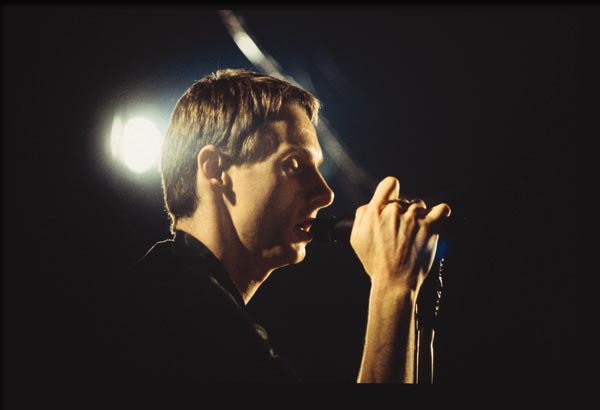24 Hour Party People: Pandemonium in Manchester

24 Hour Party People, as written by Frank Cotrell Boyce and directed by Michael Winterbottom is described by the Tony Wilson (whose character is central to the film), tongue partly in cheek, as "a collection of bloody downright lies [telling] a series of profound truths." And perhaps this might be the best that can be said about a "biopic". This movie, unlike Temple's Pandemonium, also written by Boyce, is a success because it never takes itself seriously even while handling pretty heavy subjects -- such as suicide and drug addiction. The movie tells the story of a part of the Manchester England scene from 1976, when the Sex Pistols play a show to 42 people all the way to the dissolution of the Factory record label, one of the first true independent rock labels. Along the way, we meet Ian Curtis, of Joy Division, Martin Hannet, engineer/producer extraordinaire and Shaun Ryder, a true '24 hour party person'.
Unlike other rock biopics, Party People picks a seemingly minor character to tell the story of these compelling characters. Tony Wilson is one of those goofy reporters that every local station has. This brings some absurd comedic scenes such as Wilson hang-gliding (and crashing - this did happen), having a town crier announce Ian Curtis's death (it didn't really happen) and ordering a duck sheep-herder around. Like Harvey Pekar in American Splendor, the actor sometimes pops out of character and pretends to be the real Tony Wilson, speaking directly to the camera and the real Wilson makes a funny cameo. Other real-life figures such as Howard Devoto of the Buzzcocks also make appearances -- Devoto to deny that he ever had intercourse with Wilson's wife in a bathroom stall.
Winterbottom is only partly successful at simultaneously presenting some of his subjects respectfully while demystifying them. Ian Curtis, for instance, is shown as both a song-writing genius, an enigma and a fun guy to be around. The latter is not something people might generally think of the guy who wrote "She's Come Undone" and hung himself after watching a German existential movie. But maybe because he was such an enigma, Curtis will be the subject of not one but two other upcoming pictures. However, we never really begin to understand Martin Hannett except that he was a mad genius.
 Shaun Ryder is presented as a bit of a lout whose best inspiration came from designer drugs -- but we knew that. However I think because the latter two were not as well known, Party People provides a good overview of what made them special.
Shaun Ryder is presented as a bit of a lout whose best inspiration came from designer drugs -- but we knew that. However I think because the latter two were not as well known, Party People provides a good overview of what made them special.
Compared to Julien Temple's Pandemonium, Party People had a much more visual and easier subject to address. Both movies try to capture artistic movements, mad geniuses, their flaws/strengths and their effects, negative or positive, on others. Because the events of the movie were more recent, the movie is not able to take as much artistic license in imagining events. Party People also doesn't let the movie get too hijacked by the drug scenes and altered realities whereas in Pandemonium they drag the movie down. But Pandemonium graphically shows the results of creative drug use while Party People fails to show the ultimate disposition of Ryder who crashed hard and has never been able to get his music career back online (Ian Curtis, an epileptic, was not much of a drug user). One criticism about Party People is that it is about a relatively obscure music scene - but I think that's part of the point of it. The music can attest to the excitement that was going down in Manchester and the fact that it thrived without popular attention was part of the point of the film. Whether Shaun Ryder's lyrics will ever be as revered as Colderidge is perhaps something that we may not learn in our lifetime.
In the end, though, I can't really recommend Pandemonium over this movie.

1 Comments:
This comment has been removed by a blog administrator.
Post a Comment
<< Home